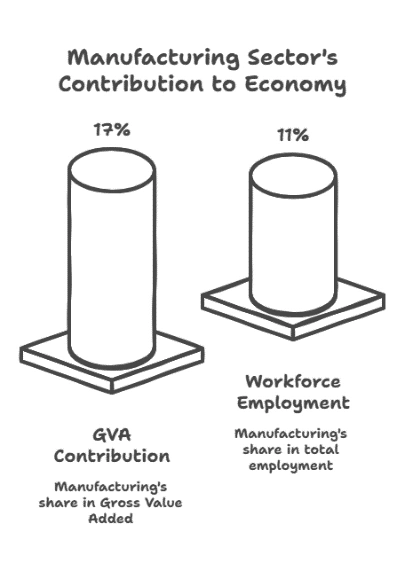Paper: GS – III, Subject: Economy, Topic: Industry and Industrial Policies, Issue: Strengthening Manufacturing sector base.
Context:
India is at a strategic moment in its economic journey amid global supply chain realignment. Manufacturing can become a growth engine, generate employment, and enhance resilience which is critical to the Viksit Bharat (Developed India) vision and national security.
Key Highlights:
Manufacturing Sector’s contribution to economy:
- Growing middle class, young workforce, and resource base.
- Needs policy reforms and targeted interventions to fully realize potential.

Five-Pillar Strategy for Manufacturing Competitiveness:
- Empower the National Manufacturing Mission:
Objective:
- Raise manufacturing share in GDP to 25%.
- Scale up merchandise exports to $1 trillion by 2030.
Implementation:
- Operationalize Manufacturing mission with a cross- ministerial action-oriented plan.
Impact:
- Create jobs at scale.
- Emphasis on Three-tier governance model, Outcome-based oversight and Time-bound implementation.
- Bridge the Missing Middle in Capital Access:
- Objective: Enable technology upgrades for global competitiveness.
- Challenge: Small and mid-sized enterprises (SMEs) struggle with financing.
- Ways to materialise:
- Use fund-of-funds model to support mid-sized firms (₹200 crore–₹1,000 crore turnover).
- Leverage successful startup funding models.
- Accelerate Industrial Infrastructure Development:
- Objective: Develop a world-class national framework for land acquisition.
- Focus on:
- Environmental and legal clearances.
- Smart industrial cities near major corridors.
- Efficient logistics & utilities.
- Ways to materialise:
- Partner with states such as Andhra Pradesh, and Maharashtra to scale infrastructure like Sri City and Auric.
- Attract anchor investors for cluster-based manufacturing.
- Rationalize Tariffs and Power Costs:
- Challenge: High input costs remain a major bottleneck.
- Reforms needed:
- Rationalize tariffs.
- Eliminate cross-subsidization.
- Enhance power cost-efficiency.
- Expand national infrastructure connectivity:
- Use Dedicated Freight Corridors, Industrial Corridors, and East-West, North-South economic corridors.
- Smart Manufacturing and Digital Readiness:
- Industry 5.0: Focus on AI, robotics, automation, analytics.
- Implementation through:
- National Digital Manufacturing Framework.
- Develop Centres of Excellence for Industry 4.0.
- Leverage tools like digital twins, real-time analytics, and AI-driven design/manufacturing.
Conclusion:
- India must grab the opportunity to:
- Become a global manufacturing hub.
- Reach $1 trillion exports.
- Enable $30 trillion GDP economy by 2047.
La Excellence IAS Academy, the best IAS coaching in Hyderabad, known for delivering quality content and conceptual clarity for UPSC 2025 preparation.
FOLLOW US ON:
◉ YouTube : https://www.youtube.com/@CivilsPrepTeam
◉ Facebook: https://www.facebook.com/LaExcellenceIAS
◉ Instagram: https://www.instagram.com/laexcellenceiasacademy/
GET IN TOUCH:
Contact us at info@laex.in, https://laex.in/contact-us/
or Call us @ +91 9052 29 2929, +91 9052 99 2929, +91 9154 24 2140
OUR BRANCHES:
Head Office: H No: 1-10-225A, Beside AEVA Fertility Center, Ashok Nagar Extension, VV Giri Nagar, Ashok Nagar, Hyderabad, 500020
Madhapur: Flat no: 301, survey no 58-60, Guttala begumpet Madhapur metro pillar: 1524, Rangareddy Hyderabad, Telangana 500081
Bangalore: Plot No: 99, 2nd floor, 80 Feet Road, Beside Poorvika Mobiles, Chandra Layout, Attiguppe, Near Vijaya Nagara, Bengaluru, 560040

